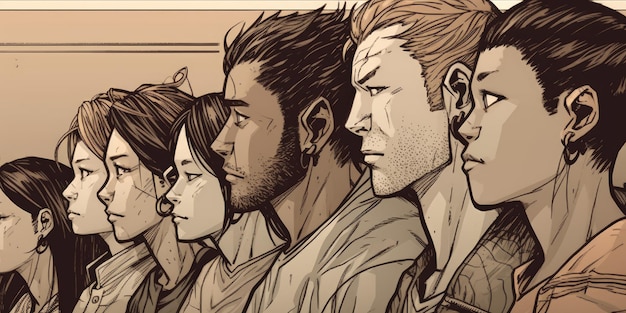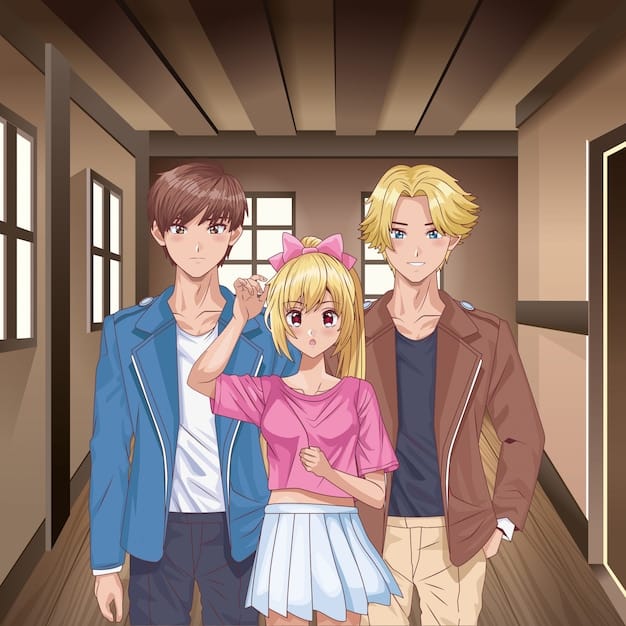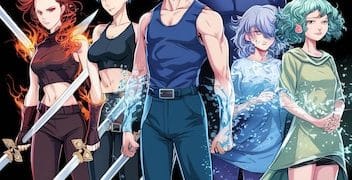How to Write a Shonen Manga Protagonist US Readers Will Love

Writing a compelling Shonen manga protagonist that US readers will love involves creating a relatable character with a clear goal, strong values, and the ability to overcome challenges, all while resonating with American cultural sensibilities.
Creating a memorable protagonist is key to the success of any Shonen manga, but capturing the hearts of US readers requires a nuanced approach. This guide dives into how to write a compelling Shonen manga protagonist that US readers will love, exploring the essential elements that resonate with a Western audience.
Understanding the Shonen Genre and US Audience
Shonen manga, aimed primarily at a young male audience, is characterized by action-packed stories, strong themes of friendship and perseverance, and a clear focus on character development. However, the nuances of what resonates with US readers may differ from a Japanese audience. Understanding these differences is crucial for creating a protagonist that connects.
US readers often appreciate protagonists who demonstrate a strong sense of individuality and challenge authority when necessary. While respecting traditional values is important, a blind adherence to them may not be as appealing. Cultivating complexity in your protagonist will also allow them to be more realistic- and compelling- than characters that are less well-rounded.
Key Differences in Cultural Sensibilities
When crafting a Shonen protagonist for US readers, it’s important to be aware of the cultural differences that can impact how a character is perceived. Here are some aspects to consider:
- Individuality vs. Collectivism: US culture values individuality and self-reliance. Protagonists who prioritize personal growth and make individual choices are often more relatable than those who strictly adhere to group harmony.
- Directness vs. Indirectness: American readers tend to appreciate direct communication and honesty. Protagonists who are forthright and express their opinions openly may be better received than those who are overly reserved or rely on subtle cues.
- Challenge to Authority: US audiences often admire characters who question authority and stand up for their beliefs, even if it means going against the grain. Blind obedience is less valued than independent thinking.
- Diversity and Representation: The US is a melting pot of cultures, and readers appreciate seeing diverse characters and stories that reflect their own experiences. Consider incorporating diverse backgrounds, ethnicities, and perspectives into your protagonist.
By understanding these cultural nuances, you can create a Shonen protagonist who not only embodies the core values of the genre but also resonates with the specific sensibilities of US readers. This will help your manga stand out and connect with a wider audience.
Therefore, understanding the landscape of Shonen Manga and the US Audience helps to create a compelling story with a protagonist that the western audience can enjoy.
Crafting a Relatable Backstory
A protagonist’s backstory is the foundation of their character. It shapes their motivations, values, and relationships. For US readers, a relatable backstory often involves overcoming adversity, facing challenges, or experiencing significant loss. This provides a foundation for understanding their motivation and sympathizing with their struggles.
While tragic backstories can be compelling, it’s essential to avoid clichés. Instead, focus on creating a backstory that feels authentic and relevant to the protagonist’s personality and journey. Consider what events have shaped their worldview and how they respond to those experiences. Be sensitive when incorporating harmful elements or stereotypes into their background.

Common Backstory Tropes to Avoid
While drawing inspiration from existing tropes can be helpful, it’s important to avoid relying on them too heavily. Here are some common backstory tropes that US readers may find predictable or unoriginal:
- The Orphaned Protagonist: While the orphaned protagonist is a classic trope, it can feel overused if not handled with nuance. Consider exploring alternative family dynamics or giving the protagonist a unique reason for being separated from their parents.
- The Chosen One: Protagonists who are destined for greatness from birth can feel less relatable than those who earn their success through hard work and determination. Instead of relying on destiny, focus on showcasing the protagonist’s efforts and growth.
- The Tragic Past with No Resolution: A tragic past can be a powerful motivator, but it’s important to provide some sense of resolution or healing. Protagonists who are constantly dwelling on their past without making progress can feel stagnant and uninspired.
Creating a unique backstory that avoids these pitfalls will help your protagonist stand out and capture the attention of US readers. Now it’s time to craft a character that an audience will love to follow.
Designing a captivating backstory is about creating a character people want to cheer for, so be mindful and respectful of the audience.
Defining Clear Goals and Motivations
A compelling Shonen protagonist needs a clear goal that drives their actions and motivates them to overcome obstacles. This goal should be relatable to US readers, even if the context is fantastical. Common goals include protecting loved ones, achieving personal growth, or righting a wrong. What makes the character and his goals unique?
The protagonist’s motivations should be deeply personal and tied to their backstory. Understanding why they want to achieve their goal is just as important as knowing what the goals are. US readers appreciate protagonists who are driven by strong convictions and unwavering determination. The character goals also have to be clearly defined for the audience to connect them to the character’s values.
Examples of Compelling Goals
Here are some examples of compelling goals that can resonate with US readers:
- Becoming the Strongest: This classic Shonen goal can be relatable if framed as a desire for self-improvement and the ability to protect others.
- Saving the World: This goal can be compelling if the protagonist’s motivations are personal and tied to a specific threat or injustice.
- Finding a Lost Loved One: This goal can evoke strong emotions and create a sense of urgency.
- Achieving a Dream: This goal can be inspiring and relatable, especially if the protagonist faces significant challenges along the way.
Ensuring that the character’s goals are aligned with their values is essential. Contradictory values can be confusing to US readers, making the character unlikable.
After establishing clear character goals, the audience will understand who the protagonist is, setting the stage for the hero’s journey.
Developing Strong Relationships and Rivalries
Relationships play a crucial role in Shonen manga, providing opportunities for character development, emotional growth, and comedic relief. For US readers, the relationships between the protagonist and their friends, mentors, and rivals should feel authentic and meaningful. As the story goes on, the connections must continue to feel relevant and add complexity to the main plot.
Consider creating complex and multi-faceted relationships. Avoid relying on stereotypes or tropes that can feel flat or uninspired. US readers appreciate seeing genuine connections between characters, even if those connections are fraught with conflict or rivalry. These characters may also serve as catalysts for development and growth.

Elements of a Good Rivalry
Rivalries are a staple of the Shonen genre, providing a foil for the protagonist and pushing them to grow stronger. When crafting a rivalry for US readers, consider these elements:
- Mutual Respect: Even if the rivals are constantly at odds, they should have a degree of respect for each other’s abilities and motivations.
- Shared Goal: A shared goal can create a sense of camaraderie and understanding between rivals, even as they compete.
- Personal Connection: A personal connection, such as a shared backstory or a common enemy, can add depth and complexity to the rivalry.
- Growth and Development: The rivalry should push both characters to grow and develop, both physically and emotionally.
Avoid creating rivalries that are based solely on jealousy or spite. US readers tend to appreciate rivalries that are rooted in mutual respect and a desire to improve.
The supporting cast of characters and rivals add depth and dimensions to a series and creates a unique and memorable story with emotional depth.
Embracing Character Flaws and Growth
Perfect protagonists are boring. US readers appreciate characters who have flaws, weaknesses, and vulnerabilities. These imperfections make the protagonist relatable and human, allowing readers to connect with them on a deeper level. Be transparent with your readers. What are the protagonist’s blind spots and shortcomings?
However, it’s important to balance flaws with strengths. The protagonist’s flaws should not overshadow their positive qualities or make them unlikable. Instead, the flaws should serve as opportunities for growth and development. As the story progresses, the protagonist should learn from their mistakes and overcome their weaknesses, demonstrating resilience and determination.
Ways to Showcase Character Growth
Here are some ways to showcase character growth in a Shonen manga:
- Learning from Mistakes: Protagonists can demonstrate growth by acknowledging their mistakes and taking steps to correct them.
- Overcoming Weaknesses: Protagonists can demonstrate growth by identifying their weaknesses and working to improve them.
- Developing New Skills: Protagonists can demonstrate growth by learning new skills and abilities that help them achieve their goals.
- Changing Their Perspective: Protagonists can demonstrate growth by evolving their perspective on the world and their place in it.
Highlighting internal flaws and exploring the internal and external struggles in the story arc develops a deep and engaging storyline.
Character growth has to be consistent and organic in the story and must reflect real, believable change. It should always feel earned and not come out of nowhere.
Balancing Humor, Action, and Emotional Depth
Shonen manga is known for its blend of humor, action, and emotional depth. Striking the right balance between these elements is key to creating a compelling story that appeals to US readers. Depending on the series, there may be more action or humor, but the storyline should remain balanced.
Humor can be used to lighten the mood, provide comedic relief, or create unique character dynamics. However, it’s important to avoid humor that is offensive, insensitive, or relies on tired stereotypes. Action sequences should be exciting and visually engaging, but they should also serve a purpose in the story. Action is not only external conflict, but internal conflict as well. How do these moments propel the story forward?
How to Add Emotional Weight
Here are some ways to add emotional depth to a Shonen manga:
- Exploring Character Backstories: Delving into the protagonist’s past can reveal their motivations and vulnerabilities, creating a deeper connection with readers.
- Developing Meaningful Relationships: Showcasing the protagonist’s relationships with friends, family, and rivals can add emotional depth and create opportunities for character growth.
- Addressing Difficult Themes: Exploring difficult themes such as loss, grief, or injustice can add emotional weight to the story and resonate with readers.
- Showcasing Vulnerability: Allowing the protagonist to express vulnerability and show their emotions can make them more relatable and sympathetic.
The core themes and values should also be easily relatable to US readers, so they can easily engage and participate in the world you’re creating. If values are hard for a western audience to understand, it can create a disconnect with the story.
Successfully blending these elements is what makes Shonen manga great and engaging for a wide audience.
| Key Aspect | Brief Description |
|---|---|
| 🌟 Relatable Backstory | Develop adversity overcome or significant losses to drive motivation and character arc. |
| 🎯 Clear Goals | Define specific objectives that align with the protagonist’s values and propel their journey. |
| 🤝 Strong Relationships | Develop authentic connections with friends and rivals to enhance character growth. |
| 🎭 Character Flaws | Integrate imperfections that allow for relatable growth and demonstrate resilience. |
FAQs
US readers often find Shonen protagonists relatable when the characters exhibit individuality, honesty, and a strong sense of justice. Protagonists who challenge authority and uphold their values resonate well.
The backstory is extremely important for shaping the protagonist’s motivations and values. It should be authentic and engaging, providing depth and understanding to their actions and decisions.
Avoid overused tropes like orphaned protagonists or the “chosen one” narrative without a unique twist. Ensure that tragic pasts lead to resolution over time, allowing for character progression.
Rivalries should include mutual respect and growth, often sharing a common goal or personal connection. Rivalries that arise from jealousy are less relatable and should be avoided for stronger narratives.
Flaws make characters feel more human and relatable. These imperfections should provide opportunities for growth and learning, showing resilience and determination as the character evolves throughout the story.
Conclusion
Crafting a Shonen manga protagonist that resonates with US readers involves thoughtful character design, compelling backstory, a clear set of goals, well-developed relationships, intriguing flaws, and a great sense of balance. By considering these factors, manga artists and writers can create a character that meets the expectations of a new audience while staying true to the core values of storytelling.





